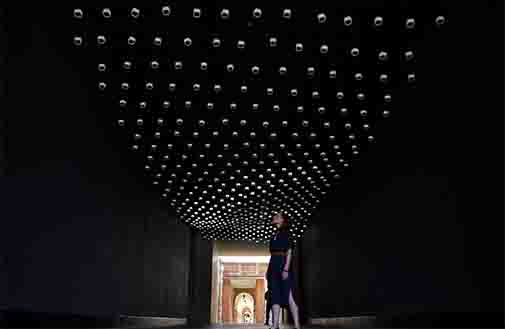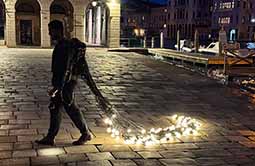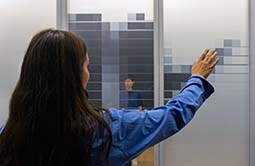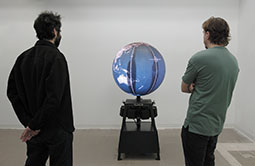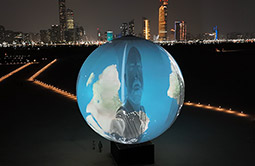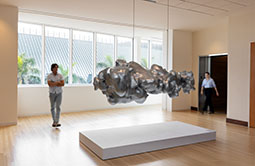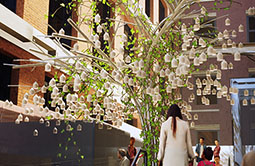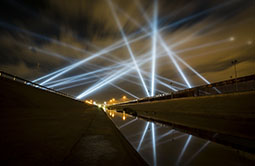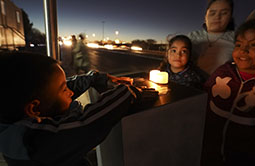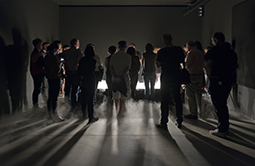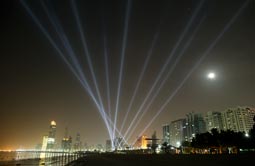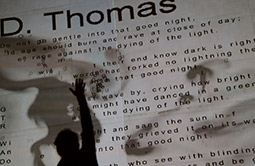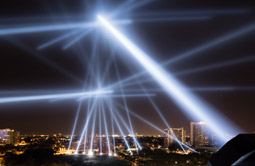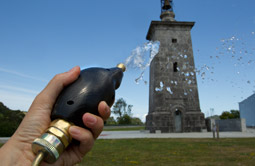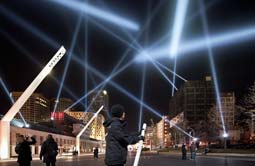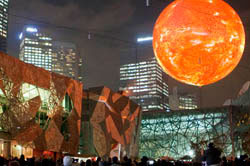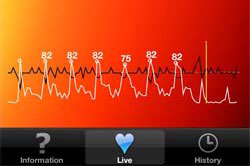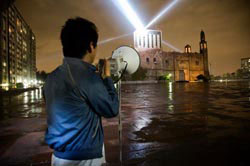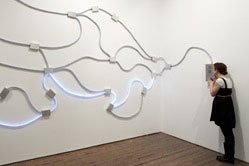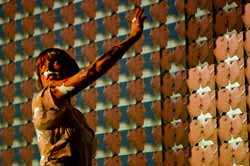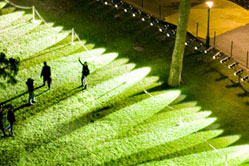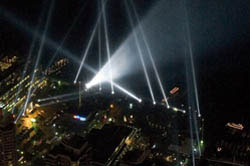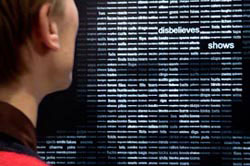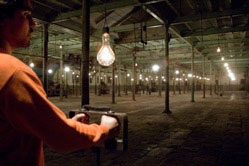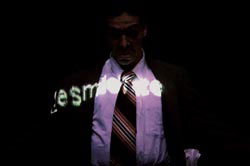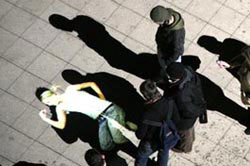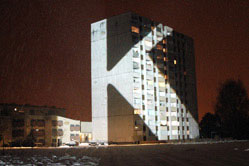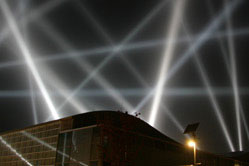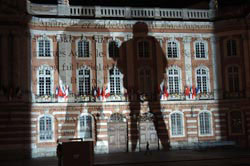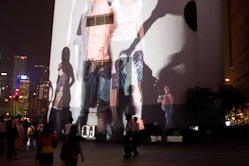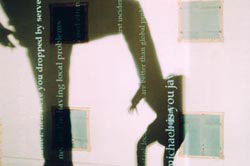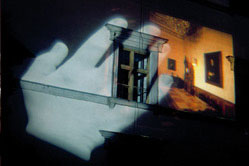Climate Parliament
2024
“Climate Parliament” is an interactive sound and light installation featuring thousands of audio channels playing on small, custom-made loudspeakers, suspended under the ceiling of a semi-outdoor passageway at Rice University. The speakers are hung out of reach of passers-by in a regular, but staggered formation that creates semi-circular archways with a six-foot radius.
View details.
View details.
Pulse Agglomerate
2024
"Pulse Agglomerate," a biometric performance, was presented during the 60th Venice Biennale. The piece consisted of a wearable armature that powered, controlled, and hauled hundreds of lightbulbs, each glimmering to the pulse of a different participant from the past. The performer wearing the piece walked around the streets of Venice, collecting one hundred heartbeats using an onboard pulse sensor.
View details.
View details.
Transparency Display
2024
“Transparency Display” is an interactive glass triptych that reveals and conceals portraiture in real-time using the transparency and translucency of liquid crystal pixels embedded in glass panels. The piece automatically creates low-definition portraits of the viewers, which can be seen from either side of the triptych, regardless of the lighting conditions or time of day. Through these fleeting portraits a visitor on one side can see visitors on the other side, creating an uncanny and ever changing portal between them. Inspired by Dan Graham's reflective and refractive glass pavilions, Sharon Grace's digital pictures in picture, and Kit Galloway and Sherrie Rabinowitz's "Hole in the Wall" performance, the work converts an architectural subdivision into a connective switchboard for eye contact, shadow play, and sous- and surveillance.
View details.
View details.
Shadow Tuner - Standalone
2024
An animated image of the Earth rotates on a sphere. As people approach and move around it, their movements are tracked and reflected on the sphere as black shadows. As shadows cover different cities, they automatically trigger live, local radio stations from those locations, thus creating a global polyphonic tuning device. This artwork is available as both an inflatable public sculpture and a standalone domestic piece.
View details.
View details.
Shadow Tuner
2023
An animated image of the Earth rotates on a sphere. As people approach and move around it, their movements are tracked and reflected on the sphere as black shadows. As shadows cover different cities, they automatically trigger live, local radio stations from those locations, thus creating a global polyphonic tuning device. This artwork is available as both an inflatable public sculpture and a standalone domestic piece.
View details.
View details.
Volute 2: Listen to the World
2023
In the "Volute" series —words, phrases, and songs—are rendered into turbulent clouds containing layers of complex folds and vortices, with a method developed by Lozano-Hemmer's studio in conjunction with fluid dynamic scientists from Georgia Institute of Technology, Auburn University, and NYU. A custom-made laser tomograph scans the breath exhaled while spoken, then converts it into a 3D shape using photogrammetry.
View details.
View details.
Speaking Willow
2020
“Speaking Willow” is a sound sculpture in the shape of a weeping willow tree, between 16 and 20 feet high, which adorns the entrance of the Planet Word Museum. The tree sculpture is fabricated in aluminum and is hollow, except the trunk and branches carry inside data cables that emerge from the structure and hang vertically, slowly swaying with the wind. The tree is covered by living vine, Ivy or other evergreen climbing plants that warm-up the design.
View details.
View details.
Border Tuner / Sintonizador Fronterizo
Relational Architecture 23, 2019
"Border Tuner" is a large-scale, participatory art installation designed to interconnect the cities of El Paso, Texas, and Ciudad Juárez, Chihuahua. Powerful searchlights make “bridges of light” that open live sound channels for communication across the US-Mexico border. The piece creates a fluid canopy of light that can be modified by visitors to six interactive stations, three placed in El Paso and three in Juárez.
View details.
View details.
Remote Pulse
2019
“Remote Pulse” is an interactive installation consisting of two identical pulse-sensing stations that are interconnected over the internet. When a person places their hands on one station automatically the person on the other station feels their pulse, as the plates vibrate in sync with the heartbeat of the remote person, and vice versa. The piece was originally presented as part of Lozano-Hemmer’s “Border Tuner” installation across the US-Mexico border.
View details.
View details.
Pareidolium
2018
“Pareidolium” is a circular fountain that creates portraits of onlookers in mid-air with clouds of vapor that ascend from the water basin. As a visitor looks into the water, a facial-detection system extracts their image and creates an ephemeral likeness in cold vapour. The portrait becomes tangible, almost breathable, only briefly, then disappears in turbulence.
View details.
View details.
Bilateral Time Slicer
2016
“Bilateral Time Slicer” is a biometric tracking system that finds the axis of symmetry of members of the public and splits a live camera image into two slices. With each new participant time slices are recorded and pushed aside. When no one is viewing the work, the slices close and rejoin creating a procession of past recordings.
View details.
View details.
Volute
2016
In the "Volute" series —words, phrases, and songs—are rendered into turbulent clouds containing layers of complex folds and vortices, with a method developed by Lozano-Hemmer's studio in conjunction with fluid dynamic scientists from Georgia Institute of Technology, Auburn University, and NYU. A custom-made laser tomograph scans the breath exhaled while spoken, then converts it into a 3D shape using photogrammetry.
View details.
View details.
Call on Water
2016
Call on Water is a fountain that writes words in mid-air with plumes of cold vapour that ascend from a water basin. Dozens of poems by Mexican writer Octavio Paz are presented which describe readable air, the moment when the written word is spoken and becomes the atmosphere itself. The poems’ content becomes tangible briefly, almost breathable, then disappears in turbulence.
View details.
View details.
Pulse Corniche
Relational Architecture 22, 2015
“Pulse Corniche” (Relational Architecture 22) was an interactive canopy of powerful light beams projected into to the sky by robotic searchlights whose brightness and orientation was controlled by the heart-rate of visitors to the Abu Dhabi’s Corniche. People were free to participate by holding a sensor placed in the centre of the plaza that converted the electrical activity of their heart into a unique lighting sequence. The intensity and direction of the lights visualized the different biometric rhythms of each participant, in an urban scale.
View details.
View details.
Airborne Newscasts
Relational Architecture 20, 2013
"Airborne Newscasts" (Relational Architecture 20) is an interactive installation originally commissioned by the Chrysler Museum of Art to transform Norfolk, Virginia’s public space into a poetic shadow play. By blocking the light of two projectors, participants cast their shadows onto a 900-square-metre wall, and these shadows are tracked by computerized surveillance systems. Out of the shadows emanate billowing smoke which is mapped onto the wall, slowly accumulating within it. Turbulent clouds of live newscasts evaporate from the “heat” of the tracked bodies.
View details.
View details.
Open Air
Relational Architecture 19, 2012
“Open Air” (Relational Architecture 19) was an interactive artwork that allowed participants’ voices to transform the sky over Philadelphia. Using a website or a free iPhone app participants could record a voice message and listen to and rate other entries. The messages were played-back over the Benjamin Franklin Parkway using 24 powerful robotic searchlights that reacted, both in brightness and position, to the voice’s frequency and volume as well as to the phone's GPS location.
View details.
View details.
Pulse Drip
2012
“Pulse Drip” is an interactive installation originally developed for Urdaibai Art 2012 in which the public can water the lawn at the Torre de Madariaga using a water hose with a heart rate sensor built-in.
View details.
View details.
Articulated Intersect
Relational Architecture 18, 2011
"Articulated Intersect" (Relational Architecture 18) is a large-scale installation that produces an interactive canopy of light that can be modified by the public using six large lever-controllers that protrude from the ground. As a participant points one of these levers three powerful robotic searchlights automatically intersect in the sky to create an apex at that location. The participant may direct the apex anywhere over the city in real-time, creating an animated tetrahedron inspired by the work of Richard Buckminster Fuller.
View details.
View details.
Sandbox
Relational Architecture 17, 2010
“Sandbox” (Relational Architecture 17) is a large-scale interactive installation created originally for Glow Santa Monica. The piece consists of two small sandboxes where one can see tiny projections of people who are at the beach. As participants reach out to touch these small ghosts, a camera detects their hands and relays them live to two of the world's brightest projectors, which hang from a boom lift and which project the hands over 8,000 square feet of beach. In this way people share three scales: the tiny sandbox images, the real human scale and the monstrous scale of special effects.
View details.
View details.
Solar Equation
Relational Architecture 16, 2010
"Solar Equation" is a large-scale public art installation that consists of a faithful simulation of the Sun, 100 million times smaller than the real thing. Commissioned by the Light in Winter Festival in Melbourne, the piece features the world’s largest spherical balloon, custom-manufactured for the project, which is tethered over Federation Square and animated using five projectors. The solar animation on the balloon is generated by live mathematical equations that simulate the turbulence, flares and sunspots that can be seen on the surface of the Sun. This produces a constantly changing display that never repeats itself, giving viewers a glimpse of the majestic phenomena that are observable at the solar surface and that only relatively recent advances in astronomy have discovered. Using an iPhone, iPod touch or iPad, people may disturb the animations in real-time and select different fluid dynamic visualizations.
View details.
View details.
Pulse Phone
2009
“Pulse Phone” is an application that measures your heart rate by using the iPhone's built-in camera and flash. The application detects small variations in the opacity of your finger as blood flows through it and calculates your pulse in beats per minute using this information. The app visualizes the data graphically and can store it for later reference.
View details.
View details.
Voz Alta
Relational Architecture 15, 2008
"Voz Alta" (Loud Voice)(Relational Architecture 15) is a memorial commissioned for the 40th anniversary of the student massacre in Tlatelolco. Participants who speak into a megaphone automatically control the brightness of four searchlights that relay their voice over Mexico City as quiet light flashes; tuning into 96.1FM radio allows people anywhere in the city to listen in live to what the lights are saying.
View details.
View details.
Apostasis
2008
An interactive installation featuring powerful robotic searchlights that create static columns of light in a dark room. When someone tries to walk into a light beam, a computer automatically moves the searchlight so that the beam is pointed somewhere else on the room. A video tracking system observes the room and makes sure that the lights are always illuminating empty spaces where there is no one. People may continually attempt to enter the spotlight but the system will adapt to ensure this can never be achieved.
View details.
View details.
Less Than Three
2008
"Less than Three" is an interactive installation of light strips that form a network between two intercoms. As a participant speaks into an intercom, their voice is translated into corresponding flashes of light and this light pattern is transmitted visually along one of the several possible pathways through the network. When it reaches the other side, the viewer's phrase is once again released as sound. Several voices can be carried simultaneously and the short contributions going fast through the network and the longer ones taking longer.
View details.
View details.
Make Out
Shadow Box 8, 2008
"Make Out" (Shadow Box 8) is an interactive piece showing thousands of internet videos of couples looking at each other. As soon as a participant stands in front of the display his or her silhouette is shown and all the couples within it begin to kiss. The massive array of make-out sessions continues for as long as someone is in front of the work—as he or she moves away all the kissing ends.
View details.
View details.
Pulse Park
Relational Architecture 14, 2008
"Pulse Park" (Relational Architecture 14) is comprised of a matrix of light beams that grazed the central oval field of Madison Square Park, New York City. The intensity of each spotlight is entirely modulated by a sensor that measures the heart rate of participants. The resulting effect is a visualization of the body's vital signs, arguably our most symbolic biometric, at an immense scale and in an urban setting.
View details.
View details.
Pulse Front
Relational Architecture 12, 2007
"Pulse Front" (Relational Architecture 12) was an interactive light installation over Toronto's Harbourfront Centre, consisting of a matrix of light beams from twenty powerful robotic searchlights controlled by a network of sensors that measured the heart rate of passers-by. Ten metal sculptures detected and measured the pulse of people who held them and their readings were immediately converted into light pulses and also determined the orientation of the beams.
View details.
View details.
Third Person
Shadow Box 2, 2006
"Third Person" (Shadow Box 2) is the second piece of the ShadowBox series of interactive displays with a built-in computerized tracking system. This piece shows the viewer's shadow revealing hundreds of tiny words that are in fact all the verbs of the dictionary conjugated in the third person. The portrait of the viewer is drawn in real time by active words, which appear automatically to fill his or her silhouette. The collector may choose to display the words in English, Spanish or French, or a combination of the three languages.
View details.
View details.
Pulse Room
2006
"Pulse Room" is an interactive installation featuring one to three hundred clear incandescent light bulbs, 300 W each and hung from a cable at a height of three metres. The bulbs are uniformly distributed over the exhibition room, filling it completely. An interface placed on a side of the room has a sensor that detects the heart rate of participants. When someone holds the interface, a computer detects his or her pulse and immediately sets off the closest bulb to flash at the exact rhythm of his or her heart.
View details.
View details.
Subtitled Public
2005
"Subtitled Public" consists of an empty exhibition space where visitors are detected by a computerised surveillance system. When people enter the space, the system generates a subtitle for each person and projects it onto him or her: the subtitle is chosen at random from a list of all the verbs conjugated in the third person. The only way of getting rid of a subtitle is to touch another person, which leads to the two subtitles being exchanged.
View details.
View details.
Under Scan
Relational Architecture 11, 2005
"Under Scan" (Relational Architecture 11) is a public art installation based on self-representation. Thousands of "video-portraits" taken in Derby, Leicester, Lincoln, Northampton and Nottingham are projected onto the ground; at first, the portraits are not visible because the space is flooded by white light coming from a high-powered projector. As people walk around the area, their shadows are cast on the ground, revealing the video-portraits in short sequences.
View details.
View details.
1000 Platitudes
2003
"1000 Platitudes" is a large-scale photographic intervention project. It is comprised of photomontages and a video with 1,000 words or expressions commonly used to promote globalized cities to potential investors, such as "open", "modern", "clean", "multicultural" and "cosmopolitan". To make these images, a powerful projector (110,000 ANSI lumens of intensity for images of up to 70 by 70 metres) was placed on a 12-ton truck with a generator, then toured across the city of Linz, Austria.
View details.
View details.
Amodal Suspension
Relational Architecture 8, 2003
“Amodal Suspension" (Relational Architecture 8) is a large-scale interactive installation in which people send short text messages to each other using a cell phone or web browser. However, rather than being sent directly, the messages are encoded as unique sequences of flashes with twenty robotically-controlled searchlights, not unlike the patterns that make up Morse code. Messages "bounce" around from searchlight to searchlight, turning the sky into a giant switchboard.
View details.
View details.
Two Origins
Relational Architecture 7, 2002
“Two Origins” (Relational Architecture 7) is an intervention in which the emblematic Place du Capitole in Toulouse was transformed by a projection of The Book of Two Origins, a 13th-century heretical manuscript compiling the theological beliefs of the dualist cathars. Once a vibrant community in several regions of Europe, the believers in the two origins of the Universe were virtually annihilated by the brutal crusades that gave birth to the Inquisition and France's expansion. The texts are illegible since they are projected overlapping each other on the same façade from two distant projectors; only when passers-by block one text with their bodies is it possible to read the other text inside their shadow.
View details.
View details.
Body Movies
Relational Architecture 6, 2001
"Body Movies" transforms public space with interactive projections measuring between 400 and 1,800 square metres. Thousands of photographic portraits, previously taken on the streets of the host city, are shown using robotically controlled projectors. However the portraits only appear inside the projected shadows of the passersby, whose silhouettes can measure between two and twenty-five metres depending on how close or far away they are from the powerful light sources positioned on the ground.
View details.
View details.
33 Questions per Minute
Relational Architecture 5, 2000
"33 Questions Per Minute" (Relational Architecture 5) consists of a computer program which uses grammatical rules to combine words from a dictionary and generate 4.7 trillion unique, fortuitous questions. The automated questions are presented at a rate of 33 per minute—the threshold of legibility. The system will take over 271,000 years to ask all possible questions.
View details.
View details.
Vectorial Elevation
Relational Architecture 4, 1999
"Vectorial Elevation" (Relational Architecture 4) is an interactive art project originally designed to celebrate the arrival of the year 2000 in Mexico City's Zócalo Square. The website www.alzado.net enabled any Internet user to design light sculptures over the city's historic centre, with eighteen searchlights positioned around the square. These searchlights, whose powerful beams could be seen within a 15 kilometers radius, were controlled by an online 3D simulation program and visualised by digital cameras. A personalised webpage was produced for every participant with images of their design and information such as their name, dedication, place of access and comments.
View details.
View details.
Re:Positioning Fear
Relational Architecture 3, 1997
"Re:Positioning Fear" (Relational Architecture 3) was a large-scale installation on the Landeszeughaus military arsenal with a "teleabsence" interface of projected shadows of passers-by. Using tracking systems, the shadows were automatically focused and generated sounds. A real-time IRC discussion about the transformation of the concept of "fear" was projected inside the shadows; the chat involved 30 artists and theorists from 17 countries.
View details.
View details.
Displaced Emperors
Relational Architecture 2, 1997
"Displaced Emperors" (Relational Architecture 2) was an interactive installation that used an "architact" —architecture meets haptics— interface to transform the facade of the Habsburg Castle in Linz, Austria. Wireless 3D sensors calculated where participants pointed to on the façade and a large animated projection of a hand was projected at that location. As people on the street "caressed" the building, they could reveal the interiors of the Habsburg residence in Mexico City, Castillo de Chapultepec.
View details.
View details.
